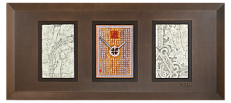Samurai
Samurai (侍) were the military nobility of premodern Japan.
Samurai warriors described themselves as followers of "The Way of the Warrior" or Bushido. Bushidō is defined by the Japanese dictionary as "a unique philosophy that spread through the warrior class from the Muromachi period.
Ancient Yayoi warriors developed weapons, armor and a code during the ensuing centuries that became the centerpiece for the Japanese Samurai.
Armor included a helmet that protected head and neck, a breastplate that protected the chest, arm and shoulder protectors, and a belly wrap. Later armor included protection for the legs and thighs. Armor changed as the type of battles changed.
Early weapons included bows, arrows and swords. The Samurai wore two swords (daisho). One was long; the other short. The long sword (daito - katana) was more than 24 inches. The short sword (shoto - wakizashi) was between 12 and 24 inches. The Samurai often gave names to their swords and believed it was the "soul" of their warriorship.
The Samurai became expert in fighting from horseback and on the ground. From the earliest times, the Samurai felt that the path of the warrior was one of honor, emphasizing duty to one's master, and loyalty until death.
As de facto aristocrats for centuries, samurai developed their own cultures that influenced Japanese culture as a whole. The culture associated with the samurai such as the tea ceremony, monochrome ink painting, rock gardens and poetry were adopted by warrior patrons throughout the centuries 1200–1600.




